Crete - the southernmost and largest of the Greek islands has "everything"! Its bountiful variety of features includes mountain villages, long sandy beaches, rocky bays, beach-bar-boogie & nightlife. There are magnificent mountain ranges, water-sports, tranquil locations and crystal clean seas. Bathed in clear sunlight most of the year, the climate is one of the best in Europe. It is understandably a most popular travel and vacation destination.
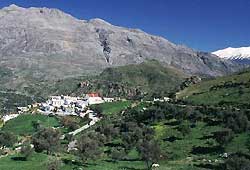 Crete
has a magic radiance, there is the supreme quality of the light here, the
sharp rugged mountains meeting openly with clear seas. There is an
abundance of wildlife, plants & flowers that are unique to the island.
Breath in the ever-present scents of wild herbs, taste fresh fruit, the
best of the world's olive oil and healthy, delicious cheeses. Enjoy the
delight of sipping a Greek coffee at the roadside in a mountain village,
the excitement and spill over of weddings and occasions, the history, and
the people. It is also a historian's and archaeologist's paradise.
Crete
has a magic radiance, there is the supreme quality of the light here, the
sharp rugged mountains meeting openly with clear seas. There is an
abundance of wildlife, plants & flowers that are unique to the island.
Breath in the ever-present scents of wild herbs, taste fresh fruit, the
best of the world's olive oil and healthy, delicious cheeses. Enjoy the
delight of sipping a Greek coffee at the roadside in a mountain village,
the excitement and spill over of weddings and occasions, the history, and
the people. It is also a historian's and archaeologist's paradise.
Because Crete is the largest of the Greek islands, it offers developed tourist areas with large resort hotels, small intimate hotels, quiet coves, hidden beaches, invigorating mountain villages and plateaus that reward the discerning traveller.
Crete is divided into 4 provinces or more correctly prefectures, Chania, Rethymno, Heraklion and Lassithi. With the exception of Lassithi, the capital of each region has the same name, in Lassithi, the main town is Agios Nikolaos.
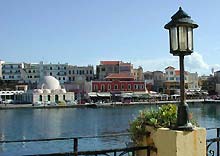 Chania Town, considered as one of the loveliest towns of Greece, has managed
to keep its local and authentic colours, despite the growing numbers of
visitors. Most popular is the beautiful Venetian castle and harbour with
its waterfront tavernas, fine restaurants and unique accommodation in
restored buildings.
Chania Town, considered as one of the loveliest towns of Greece, has managed
to keep its local and authentic colours, despite the growing numbers of
visitors. Most popular is the beautiful Venetian castle and harbour with
its waterfront tavernas, fine restaurants and unique accommodation in
restored buildings.
The Venetian and Turkish influence is quite apparent in Chania with narrow stone-paved alleys and back streets where you can find good shopping opportunities for Cretan handcrafts, such as rugs, blankets, wall hangings, and the beautiful embroideries that Crete is famous for.
Rethymno Town is divided into the Old and the New, both delightful
in their own way. An endless sandy beach spans the Rethymno coast with many modern and
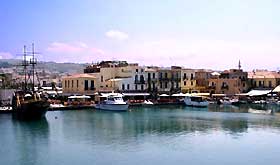 luxurious
"resort" hotels. The old part of Rethymno is particularly charming, full
of old buildings, stone paved alleys and a huge Venetian fortress that
overlooks the city.
luxurious
"resort" hotels. The old part of Rethymno is particularly charming, full
of old buildings, stone paved alleys and a huge Venetian fortress that
overlooks the city.
There are a number of elements that participate to the charm of Rethymno town such as the many arched doorways, stone staircases, 16th century buildings, Byzantine, Hellenic and Roman remains, the superb municipal gardens, waterside fish restaurants, cafes, bars and a few clubs. Like Chania, the Venetian and Turkish influences abound with minarets and domed mosques making Rethymno both popular and photogenic.
Heraklion Town is the capital of the prefecture and all Crete, an
administrative, commercial, industrial and agricultural centre of the
island with a population of about 125.000. Because of the extensive
development experienced in recent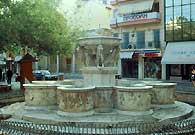 decades, Heraklion has the same problems of any large modern city -
traffic jams and parking problems, in short, Heraklion is completely
different from the beautiful towns of Chania, Rethymno and Agios Nikolaos.
decades, Heraklion has the same problems of any large modern city -
traffic jams and parking problems, in short, Heraklion is completely
different from the beautiful towns of Chania, Rethymno and Agios Nikolaos.
Despite the size and relatively modern aspect, some fine corners and
buildings have been preserved, displaying the town's glorious past. The
Old Port is ideal for pleasant evening walks. The Loggia, the most elegant
of the Venetian buildings in Heraklion. The Morosini Fountain, situated in
the middle of Venizelos square. A must for all visitors to Heraklion is
the outstanding archaeological
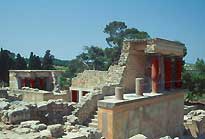 museum, in a converted power station, which houses many of the finds from Knossos,
Archanes, Phaestos, Zakros and many other archaeological sites in Crete.
museum, in a converted power station, which houses many of the finds from Knossos,
Archanes, Phaestos, Zakros and many other archaeological sites in Crete.
For many, a major reason to visit Crete is the Palace of Knossos. While in Heraklion in would take less than 30 minutes to reach the well restored Minoan Palace that was the passion of Arthur Evans, principally responsible for the masterpiece that Knossos is today.
Agios Nikolaos is the capital of the prefecture of Lassithi, a part
of Crete with Various small towns, some touristy or busy costal plus
picturesque mountain villages. You'll also find many archaeological sites
to visit as well as many beautiful
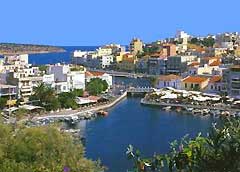 caves
and gorges. Agios Nikolaos is a lovely city, built on Mirabello Bay, where
old buildings harmoniously blend with the modern.
caves
and gorges. Agios Nikolaos is a lovely city, built on Mirabello Bay, where
old buildings harmoniously blend with the modern.
Both cosmopolitan and traditional, giving shelter to luxury yachts and the boats of local fishermen bringing in the catch of the day. The picturesque port is ideal for romantic and relaxing walks and the waterfront is boarded by traditional cafes, modern cafeterias and all sorts of small shops welcoming visitors and locals alike.
A little to the north of Agios Nikolaos is the well developed beach resort of Elounda, to the east is the famous palm-tree forest and splendid beach at Vai. while a visit to the nearby island of Spinalonga will remind you of it's historical past when it was once a Venetian fortress.
A more abstract division of Crete is the North/South divide. The main towns of the prefectures are all on the north coast of Crete and this north coast is considerably more developed in terms of commercial tourism. In the north of Crete you will find a very diverse selection of hotels including large resort hotels, some of the finest to be found anywhere in Greece.
The south coast is certainly less populated but still exceptionally busy during the summer months. The towns and villages of the south are smaller than the north, extending a more intimate side of Crete with a better opportunity to experience the traditional aspects that Crete is so famous for.
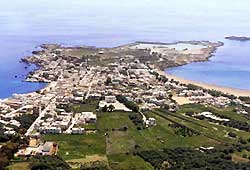 Paleohora
is a pleasant and friendly village on the south-west tip of Crete, 75
kilometres from Chania. Built on a peninsular, Plaeohora sports a pebble
beach to the east and an extensive sandy beach to the west side so one of
the beaches is always protected from the wind. A lively village, that
becomes very busy during high season, with various restaurants serving all
kind of cuisine, plenty of shops and some lively bars and clubs staying
open until dawn. A coastal ferry service connects Paleohora with Sougia,
Agia Roumeli (for Samaria gorge), Loutro and Chora Sfakia. Also a
point to set sail to the southernmost island of Gavdos.
Paleohora
is a pleasant and friendly village on the south-west tip of Crete, 75
kilometres from Chania. Built on a peninsular, Plaeohora sports a pebble
beach to the east and an extensive sandy beach to the west side so one of
the beaches is always protected from the wind. A lively village, that
becomes very busy during high season, with various restaurants serving all
kind of cuisine, plenty of shops and some lively bars and clubs staying
open until dawn. A coastal ferry service connects Paleohora with Sougia,
Agia Roumeli (for Samaria gorge), Loutro and Chora Sfakia. Also a
point to set sail to the southernmost island of Gavdos.
Matala is popular and well looked after village in an appealing location with good sandy beaches, numerous waterside cafes, gift-shops and tavernas. Close to the archaeological sites at Kommos, Gortys and Phaestos and a short drive to Agia Gallini for a change of scenery.
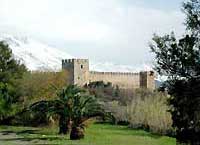 Frangokastello
is one of the picture postcard images of Crete and one of the most visited
places of the island, situated along the coast surrounded by beautiful
mountains. Public transport connections are limited but some excellent
restaurants can be found around the castle and an idyllic sandy beach with
clear shallow waters that are ideal for children.
Frangokastello
is one of the picture postcard images of Crete and one of the most visited
places of the island, situated along the coast surrounded by beautiful
mountains. Public transport connections are limited but some excellent
restaurants can be found around the castle and an idyllic sandy beach with
clear shallow waters that are ideal for children.
Plakias has a big crescent bay with a fine beach. Plakias has a unique feel about it and is quite a busy place, popular with many tourists who prefer to stay in smaller villages. Set amid some beautiful countryside with many nice walks and gorges, of particular interest is the nearby Preveli Monastery and Preveli beach.
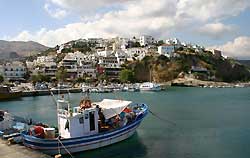 The
pretty coastal village of Agia Galini is on the southern coast of
Crete next to the border separating the prefecture of Rethymno and
Heraklion. The popularity of Agia Galini is explained by the many beauties
and charms it offers, narrow cobbled alleys snaking from the port into the
village and old houses perched one above another against a steep cliff,
offering a magnificent view over the Libyan Sea.
The
pretty coastal village of Agia Galini is on the southern coast of
Crete next to the border separating the prefecture of Rethymno and
Heraklion. The popularity of Agia Galini is explained by the many beauties
and charms it offers, narrow cobbled alleys snaking from the port into the
village and old houses perched one above another against a steep cliff,
offering a magnificent view over the Libyan Sea.
Sfakia, a small port with restaurants strung along the harbour-side. A pleasant village that has avoided the influence of commercial tourism. Friendly people and interesting walks, A small pebble beach plus a coastal ferry connection to Agia Roumeli (for Samaria gorge) and Paleohora.
There are numerous other villages in central and southern Crete that give the impression that mass tourism has not arrived on the island, many offer something of Crete that is truly special and a treat for anyone in need of the healing power of charm and character in unique climes.
Truly individual and unique places to suit any mood, pace, style or setting exist on Crete. There are walks, climbs, drives and rides that take you across stunning plateaux, dramatic mountains and along sweeping seascapes, special places "the Crete you discover".
We have made no attempt to make this a comprehensive Crete island guide. What we have tried to do is demonstrate the diversity and depth of this most unique of Greek Islands.
